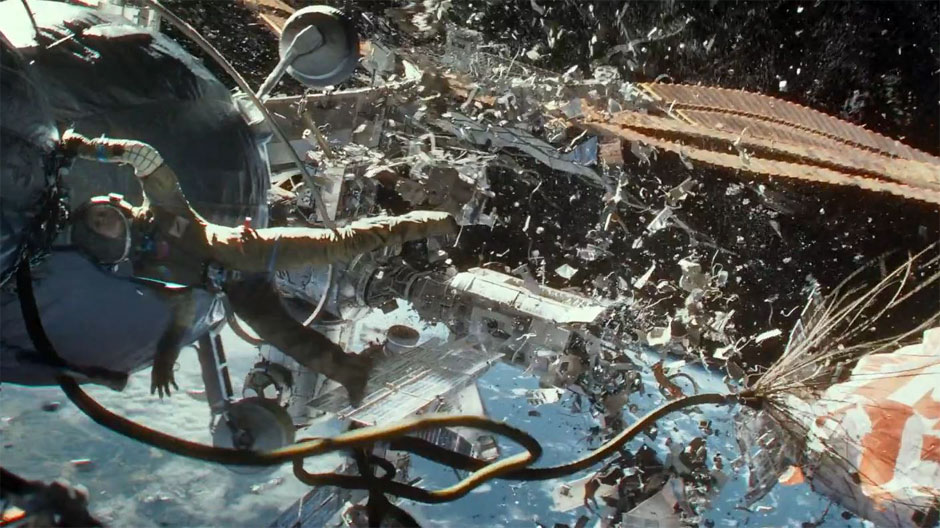I have given my review of the film, but after seeing it twice (the first time in regular 3D, second time in IMAX 3D, definitely worth seeing it in IMAX) I really felt like I should write an in-depth analysis over my interpretation of the film, simply because I want to.
Gravity is a simple film that boasts its message through vivid imagery, while also playing off the emotional fear/suspense of the audience itself. To put it plainly, Gravity is about rebirth, to rise up when life has you beaten and become something new, something stronger, you see this plainly all throughout the piece. There is also a constant struggle going on in Cuaron's film, so many times you will see an attempt to latch onto something that seems so close and you will continually see failure, there is never any immediate success. The film is an allegory of overcoming trials, when gravity pulls you down, you get back on your feet and keep moving.
One of the things Gravity portrays brilliantly is that constant of longing, of desperation to escape the peril you often believe yourself to be in. What's also interesting about this is that whenever you find yourself in the struggle it will often appear as if nobody else ever is, a kind of self-centered view of the world that everything is only bad for you, and nobody else. Take for example George Clooney's character compared to Bullock's, he often seems care-free almost, as if he is in control and has no burden weighing down upon him, especially compared to Bullock's patheticness, her trudging along as if her situation had been more dire or overbearing then Clooney. However, if you pay attention you would notice that Clooney is in the same situation as Bullock, even though Bullock had lost a daughter, Clooney had lost his wife (mentioned in the opening of the movie, she cheated on him), his character is not immune to the pain, but he is never succumbed to the tragedy, he overcomes it. Now, you could say him failing to live shows that in the end he to fell to the weight of gravity, but he dies with purpose, even through death his character overcomes fear and tragedy. Despite it looking as if Bullock was going through much more than Clooney, in reality they were faced with problems of equal magnitude but each chose to deal with them differently, and it showed how easy it was (from Bullock's point of view) to think that nothing else was being pulled down by gravity as much as her, through the shot of the frog gracefully swimming through the lake as Bullock struggles to escape, from the beauty shots of Earth while disaster struck her, and hearing the singing to a child while she accepted her death, nobody else's problems were truly, fully recognized because it was Dr. Ryan Stone's point of view of the world, an unfair tragedy pulling her down.
The most impacting theme of the movie however is that of rebirth, when the horror of life destroys you, you overcome and emerge triumphant. The images corresponding to this are the most obvious, her fetal position in the ISS showing the beginning stages, and the first person travel into the Chinese shuttle and struggling out of the water (a parallel to space) paralleled that of a child pushing their way through their mother's vagina to take that breath, to be born (in Bullock's case, reborn with a new life). The audience also feels this newness of rising from the struggle, when Bullock grasps onto the land and gasps, the audience breathes with her, through the suspenseful scenes where Bullock is sipping air, the audience is holding their breath right along with her, the film plays on the way you breathe to create a sense of relief at the end, a sense of triumph, rebirth. You see the effects of Gravity as she starts to get up, and you see her finally overcome, despite the conditions appearing to be impossible it was overcome when Bullock stopped letting the past (Gravity) pull her down, and became fresh, not letting the memories haunt her anymore, and being reborn as a stronger human.
The film also portrays images of how unnatural space is to humans, or just how unnatural everything is to human condition. This is shown beautifully with the scene in the water with Bullock and the frog gracefully swimming, as man struggles to survive, this basic, simple creature gracefully floats through its habitat. All the habitats shown in the movie worked against Bullock, the world and the environment go against man. But what's intriguing is how man, with our very limited physical capacity, go through the odds and thrive in even the harshest of environments that we seem to struggle in (especially compared to a graceful frog through the pond) and the answer is that man thrives because the habitat of man is the mind of man. The majority of the obstacles in the film were overcome through thought, the hallucinations, it all stemmed from the mind, that is because mind is the habitat of man. The mind creates our disasters for us (the Russians blowing up their satellite) and then overcomes them, it's what allows man to survive in what seems to be the harshest of environments, and that is because man is not contained to a single habitat, but brings its habitat with it wherever it goes.
This is just my brainstorm over the meaning Cuaron was displaying through the powerful images he showed us through Gravity. The film truly proves the concept that a picture is worth a thousand words.




No comments:
Post a Comment